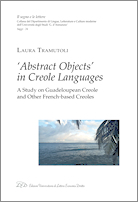
Laura Tramutoli
‘ABSTRACT OBJECTS’
IN CREOLE LANGUAGES
A Study on Guadeloupean Creole
and Other French-based Creoles
ISBN 978-88-7916-955-4 - 15 x 22 cm - 2021 - pp. 130
The term ‘abstract objects’ is introduced in linguistics by the metaphysical and logical tradition, to designate entities characterized by the absence of some fundamental physical properties, such as space-temporal localization, the ability to form cause-effect processes or the sensory perceptibility. The purpose of the book is to give an account of some particular strategies by which French-based creole languages deal with the linguistic encoding of abstract objects, when they are expressed in morphosyntactic formats of name, adjective predicate and completive clause. Three case studies are presented. The first one is dedicated to the phenomenon of article agglutination. The second case study concerns the compatibility of adjectives belonging to different semantic classes with verbal syntactic constructions and morphological markers in Haitian, Martinican and Guadeloupean Creoles. Finally, the third case study is the description of the syntactic coding in the Creole of Guadeloupe of the fact type and potential type completive clauses.
Laura Tramutoli is a PostDoc researcher in General Linguistics and Contact Linguistics at ‘G. d’Annunzio’ University, Chieti-Pescara. Her research interests concern discourse contact phenomena in the speech of migrants communities and pidgin and creole languages.

Abbreviations Used in the Glosses
1. NPs’ Genericity and Referentiality
1. Genericity – 1.1. Kind-referring NPs – 1.2. The taxonomic and quantitative function of generic NPs – 1.3. Kinds and ‘abstract objects’ – 2. Reference to ‘abstract objects’ in natural languages – 2.1. Referentiality and nonreferentiality – 2.2. Prototypical and non-prototypical NPs – 3. ‘Abstract objects’ as we mean them.
2. The Collection of Creole Data
1. Data for case study 1 – 2. Data for case study 2 – 3. Data for case study 3.
3. Case Study 1: The Semantics behind the Reanalysis of French Articles in French-based Creoles
1. The article agglutination – 2. Phono-morphology of the article agglutination: from French to – 3. Alternations – 4. Previous studies – 4.1. A complex phenomenon – 4.2. The substrate influence hypothesis – 5. The lexical-semantics aspect – 6. The morpho-syntax of NPs denoting ‘abstract objects’ – 7. An attempt of classification: semantically and formally related agglutinated nouns in French creoles – 7.1. Semantic and formal correspondences – 7.2. Class 1 – 7.3. Unique referents – 7.4. Class 2 and 3 – 8. A noun-class principle – 9. African languages.
4. Case Study 2: The Encoding of Non-prototypical Adjectives in French-based Creoles
1. The lexical reiteration constructions and TAM system in Caribbean French-based creoles (reiteration vs. reduplication) – 2. Predicate reiteration in Haitian and other Lesser Antillean creoles – 2.1. Syntactic types of predicate reiteration – 2.2. Predicate-cognate objects – 2.3. The multifunctionality of verb-cognate reiteration constructions – 2.4. The aspectual-evaluative function – 3. Compatibility of reiteration constructions with adjectival predicates – 3.1. Verbs and adjectives – 3.2. Individual-level properties and stage-level properties – 3.3. Semantic types of properties – 4. Degree achievement with imperfective marker – 5. Compatibility of individual-level properties ‘adjectives’ with intensive reiteration constructions – 5.1. Intensification of ‘adjectives’ – 5.2. Compatibility with intensive modifier bon – 6. Compatibility of individual-level properties ‘adjectives’ with attenuative reiteration constructions – 6.1. Strategies to express attenuation of a property – 6.2. Yon ti – 6.3. Reiteration constructions with yon ti to express completion and attenuation – 6.4. ompatibility of yon ti with property predicates.
5. Case Study 3: The ‘Fact Type’ Complementizer in Guadeloupean Creole
1. Complementizers in Creole languages – 2. Complement types and complement-taking predicates – 2.1. Fact type, activity type and potential type complements – 2.2. The complement-taking predicates – 3. The syntax of the facttype and potential-type completive clause in Guadeloupean Creole – 3.1. The distribution of the forms of complementizers – 3.2. The distribution of TAM markers on the main and completive verbs – 3.3. Subject coreference.